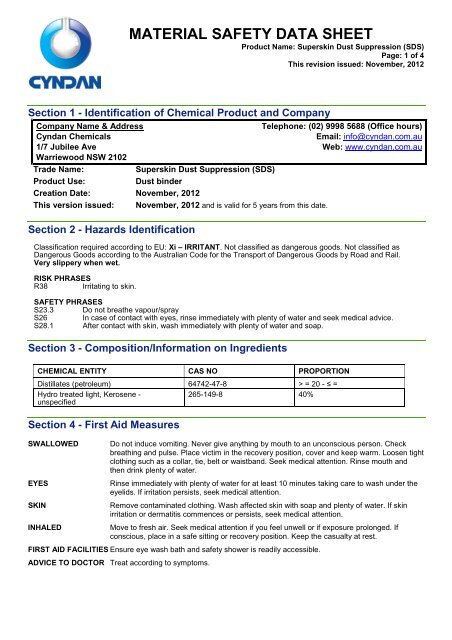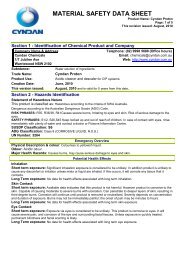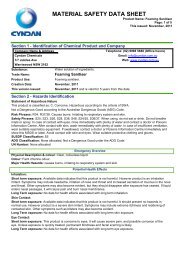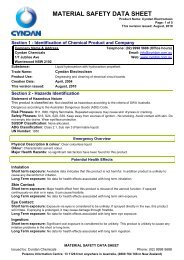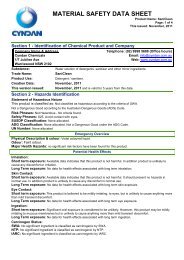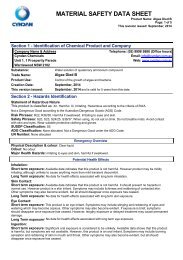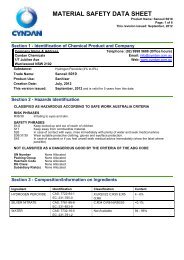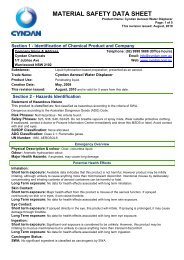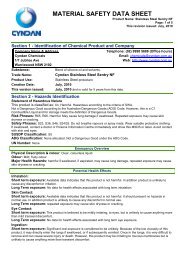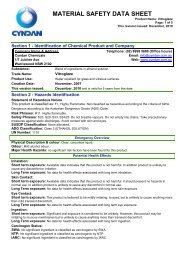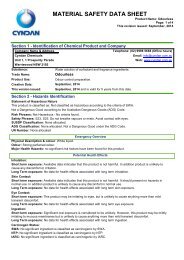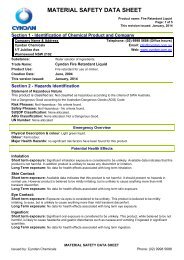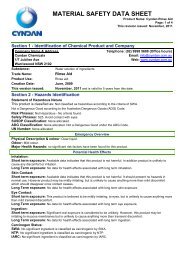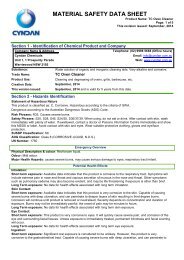Superskin Dust Suppression MSDS - CYNDAN Chemicals
Superskin Dust Suppression MSDS - CYNDAN Chemicals
Superskin Dust Suppression MSDS - CYNDAN Chemicals
You also want an ePaper? Increase the reach of your titles
YUMPU automatically turns print PDFs into web optimized ePapers that Google loves.
MATERIAL SAFETY DATA SHEET<br />
Product Name: <strong>Superskin</strong> <strong>Dust</strong> <strong>Suppression</strong> (SDS)<br />
Page: 1 of 4<br />
This revision issued: November, 2012<br />
Section 1 - Identification of Chemical Product and Company<br />
Company Name & Address<br />
Cyndan <strong>Chemicals</strong><br />
1/7 Jubilee Ave<br />
Warriewood NSW 2102<br />
Trade Name:<br />
Product Use:<br />
<strong>Dust</strong> binder<br />
<strong>Superskin</strong> <strong>Dust</strong> <strong>Suppression</strong> (SDS)<br />
Creation Date: November, 2012<br />
This version issued: November, 2012 and is valid for 5 years from this date.<br />
Section 2 - Hazards Identification<br />
Telephone: (02) 9998 5688 (Office hours)<br />
Email: info@cyndan.com.au<br />
Web: www.cyndan.com.au<br />
Classification required according to EU: Xi – IRRITANT. Not classified as dangerous goods. Not classified as<br />
Dangerous Goods according to the Australian Code for the Transport of Dangerous Goods by Road and Rail.<br />
Very slippery when wet.<br />
RISK PHRASES<br />
R38 Irritating to skin.<br />
SAFETY PHRASES<br />
S23.3 Do not breathe vapour/spray<br />
S26 In case of contact with eyes, rinse immediately with plenty of water and seek medical advice.<br />
S28.1 After contact with skin, wash immediately with plenty of water and soap.<br />
Section 3 - Composition/Information on Ingredients<br />
CHEMICAL ENTITY CAS NO PROPORTION<br />
Distillates (petroleum) 64742-47-8 > = 20 - ≤ =<br />
Hydro treated light, Kerosene -<br />
265-149-8 40%<br />
unspecified<br />
Section 4 - First Aid Measures<br />
SWALLOWED<br />
EYES<br />
SKIN<br />
INHALED<br />
Do not induce vomiting. Never give anything by mouth to an unconscious person. Check<br />
breathing and pulse. Place victim in the recovery position, cover and keep warm. Loosen tight<br />
clothing such as a collar, tie, belt or waistband. Seek medical attention. Rinse mouth and<br />
then drink plenty of water.<br />
Rinse immediately with plenty of water for at least 10 minutes taking care to wash under the<br />
eyelids. If irritation persists, seek medical attention.<br />
Remove contaminated clothing. Wash affected skin with soap and plenty of water. If skin<br />
irritation or dermatitis commences or persists, seek medical attention.<br />
Move to fresh air. Seek medical attention if you feel unwell or if exposure prolonged. If<br />
conscious, place in a safe sitting or recovery position. Keep the casualty at rest.<br />
FIRST AID FACILITIES Ensure eye wash bath and safety shower is readily accessible.<br />
ADVICE TO DOCTOR Treat according to symptoms.
Product Name: <strong>Superskin</strong> <strong>Dust</strong> <strong>Suppression</strong> (SDS)<br />
Page: 2 of 4<br />
This revision issued: November, 2012<br />
Section 5 - Fire Fighting Measures<br />
SUITABLE EXTINGUISHING<br />
MEDIA<br />
HAZARDS FROM<br />
COMBUSTION PRODUCTS<br />
PRECAUTIONS FOR FIRE<br />
FIGHTERS & SPECIAL<br />
PROTECTIVE EQUIPMENT<br />
SPECIFIC HAZARDS<br />
Foam, dry powder. If water is used, restrict pedestrian and vehicular traffic in areas<br />
where slip hazard may exist.<br />
Ammonia, Carbon and nitrogen oxides.<br />
Chemical protection suit, suitable gloves, boots and self contained breathing<br />
apparatus.<br />
In case of nearby fire, keep containers cool with water spray. Vapours may form<br />
explosive mixture with air. Do not release chemically contaminated water into<br />
drains, soil or surface water. Sufficient measures must be taken to retain the water<br />
used for extinguishing. Dispose of contaminated water and soil according to local<br />
regulations. Spilled product is slippery underfoot. Very slippery when wet. Restrict<br />
pedestrian and vehicular traffic in areas where slip hazard may exist.<br />
Section 6 - Accidental Release Measures<br />
EMERGENCY PROCEDURES<br />
METHODS AND MATERIALS<br />
FOR CONTAINMENT AND<br />
CLEAN UP<br />
User personal protective clothing. Use respiratory protection in case of insufficient<br />
ventilation.<br />
Prevent entry into sewage systems, ground and surface waters.<br />
Soak up with inert absorbent material (e.g. sand, silica gel, acid binder, universal<br />
binder, sawdust). Collect waste in suitable containers, which can be labeled and<br />
sealed. Use common salt (sodium chloride) to aid removal of residues. After<br />
cleaning, flush away traces with water. Contain wash water and dispose of in<br />
accordance with local regulations.<br />
Section 7 - Handling and Storage<br />
PRECAUTIONS FOR SAFE<br />
HANDLING<br />
CONDITIONS FOR SAFE<br />
STORAGE<br />
INCOMPATIBILITIES<br />
Do not eat, drink or smoke during work. Remove contaminated clothing<br />
immediately and launder before re-use. Open container cautiously in a well<br />
ventilated area. Ammonia vapours will collect in the container headspace. Avoid<br />
vapour formation and ignition sources. Ensure good local exhaust ventilation. Do<br />
not eat, drink or smoke at the workplace. Do not breathe vapours, spray or mist.<br />
High risk of slipping due to leakage/spillage of product.<br />
Ammonia vapours will collect in the container headspace. Keep containers tightly<br />
closed in a dry, cool and well ventilated place.<br />
Protect from heat and sources of ignition. Avoid extremes of temperature,<br />
especially frost and freezing conditions. Do not use or store in iron, copper or<br />
aluminium containers or equipment.<br />
Not available.<br />
Section 8 - Exposure Controls and Personal Protection<br />
NATIONAL EXPOSURE<br />
STANDARDS<br />
BIOLOGICAL LIMIT VALUES<br />
ENGINEERING CONTROLS<br />
64742-47-8: Distillates (petroleum), hydro treated light; Kerosene –<br />
unspecified.UK. EH40 Workplace Exposure Limits (WELs): 1,200 mg/m 3<br />
Not Available.<br />
Ensure adequate ventilation, especially in confined areas.<br />
MATERIAL SAFETY DATA SHEET<br />
Issued by: Cyndan <strong>Chemicals</strong> Phone: (02) 9998 5688<br />
Poisons Information Centre: 13 1126 from anywhere in Australia, (0800 764 766 in New Zealand)
Product Name: <strong>Superskin</strong> <strong>Dust</strong> <strong>Suppression</strong> (SDS)<br />
Page: 3 of 4<br />
This revision issued: November, 2012<br />
PERSONAL PROTECTION<br />
RESPIRATORY PROTECTION<br />
Suitable respiratory protection against hydrocarbon vapour.<br />
Wear respiratory protection if ventilation is inadequate.<br />
HAND PROTECTION<br />
Rubber or plastic gloves.<br />
EYE PROTECTION<br />
Tightly fitting safety goggles (chemical goggles).<br />
SKIN AND BODY PROTECTION<br />
Chemical resistant apron. Lightweight protective clothing.<br />
Section 9 - Physical and Chemical Properties:<br />
APPEARANCE<br />
Off-white Viscous liquid<br />
ODOUR<br />
Aliphatic<br />
pH<br />
Approx 8.0 (at 1g/L)<br />
VAPOUR PRESSURE 45 mbar (40 o C)<br />
VAPOUR DENSITY<br />
No Data<br />
BOILING POINT/RANGE<br />
> 100 o C<br />
FREEZING/MELTING POINT Approx -20 o C<br />
SOLUBILITY<br />
Dispersible<br />
SPECIFIC GRAVITY OR DENSITY No Data<br />
FLAMMABILITY<br />
None<br />
OTHER PROPERTIES<br />
SOLIDIFICATION TEMPERATURE<br />
VISCOSITY(23°C)<br />
No Data<br />
No Data<br />
Section 10 - Stability and Reactivity<br />
CHEMICAL STABILITY<br />
Stable, under normal conditions of use.<br />
CONDITIONS TO AVOID<br />
Extreme temperatures.<br />
INCOMPATIBLE MATERIALS Oxidising agent, reactive chemicals.<br />
HAZARDOUS DECOMPOSITION PRODUCTS Ammonia.<br />
HAZARDOUS REACTIONS No Data.<br />
Section 11 - Toxicological Information<br />
TOXICITY DATA FOR SIMILAR PRODUCT:<br />
No Data<br />
ACUTE & CHRONIC HEALTH EFFECTS<br />
SWALLOWED<br />
EYE<br />
SKIN<br />
INHALED<br />
CHRONIC EFFECTS<br />
Not Available<br />
Non-irritant. May cause some eye irritation which should cease after removal of the product.<br />
Irritant. In common with all mineral oils prolonged and frequent exposure may lead to skin<br />
rashes or dermatitis.<br />
High concentrations of vapour may cause irritation to eyes and respiratory system and<br />
produce narcotic effects. Ammonia vapours will collect in the container headspace.<br />
Not known.<br />
MATERIAL SAFETY DATA SHEET<br />
Issued by: Cyndan <strong>Chemicals</strong> Phone: (02) 9998 5688<br />
Poisons Information Centre: 13 1126 from anywhere in Australia, (0800 764 766 in New Zealand)
Product Name: <strong>Superskin</strong> <strong>Dust</strong> <strong>Suppression</strong> (SDS)<br />
Page: 4 of 4<br />
This revision issued: November, 2012<br />
Section 12 - Ecological Information<br />
ECOTOXICITY<br />
Oral Toxicity LD50 (Rat):<br />
No Data<br />
Fish Toxicity LC50 (Golden Orfes): No Data<br />
Bacteria Toxicity EC50: No Data<br />
Daphnia Toxicity EC50: No Data<br />
Algae Toxicity:<br />
No Data<br />
PERSISTANCE & DEGRADABILITY No Data<br />
MOBILITY<br />
No Data<br />
Section 13 - Disposal Considerations<br />
DISPOSAL METHODS<br />
SPECIAL REQUIREMENTS<br />
FOR LANDFILL OR<br />
INCINERATION<br />
Observe all local regulations.<br />
Contaminated packaging should be emptied as far as possible and disposed of in<br />
the same manner as the substance/product. Clean packaging material should be<br />
subjected to waste management schemes (recovery recycling, reuse) according to<br />
local legislation.<br />
Section 14 - Transport Information<br />
NOT CLASSIFIED AS A DANGEROUS GOOD FOR TRANSPORT.<br />
NO SPECIAL TRANSPORT REQUIREMENTS NECESSARY.<br />
UN No: None Allocated D.G. Class: None Allocated CAS No.: None Allocated<br />
Hazchem: None Allocated Sub. Risk: None Allocated Susdp.: None Allocated<br />
G.T.EPG: None Allocated Spec.EPG: None Allocated Pack.Grp: None Allocated<br />
Section 15 - Regulatory Information<br />
Poison Schedule<br />
No data.<br />
Other<br />
None.<br />
Section 16 - Other Information<br />
This <strong>MSDS</strong> contains only safety-related information. For other data see product literature.<br />
CONTACT POINT<br />
TELEPHONE (Business hours): (02) 9998 5688 Fax: (02) 9999 2086<br />
National Poisons Information Centre:<br />
Dial 13 1126 (from anywhere in Australia)<br />
THIS <strong>MSDS</strong> SUMMARISES OUR BEST KNOWLEDGE OF THE HEALTH AND SAFETY HAZARD INFORMATION OF THE PRODUCT AND<br />
HOW TO SAFELY HANDLE AND USE THE PRODUCT IN THE WORKPLACE. EACH USER SHOULD READ THIS <strong>MSDS</strong> AND CONSIDER THE<br />
INFORMATION IN THE CONTEXT OF HOW THE PRODUCT WILL BE HANDLED AND USED IN THE WORKPLACE INCLUDING IN<br />
CONJUNCTION WITH OTHER PRODUCTS. IF CLARIFICATION OR FURTHER INFORMATION IS NEEDED TO ENSURE THAT AN<br />
APPROPRIATE RISK ASSESSMENT CAN BE MADE, THE USER SHOULD CONTACT THIS COMPANY. THE RESPONSIBILITY FOR<br />
PRODUCTS SOLD IS SUBJECT TO OUR STANDARD TERMS AND CONDITIONS, A COPY OF WHICH IS SENT TO OUR CUSTOMERS AND<br />
IS ALSO AVAILABLE ON REQUEST.<br />
Please read all labels carefully before using product.<br />
This <strong>MSDS</strong> is prepared in accord with the SWA document “National Code of Practice for the Preparation of<br />
Material Safety Data Sheets” 2nd Edition [NOHSC:2001(2003)]<br />
MATERIAL SAFETY DATA SHEET<br />
Issued by: Cyndan <strong>Chemicals</strong> Phone: (02) 9998 5688<br />
Poisons Information Centre: 13 1126 from anywhere in Australia, (0800 764 766 in New Zealand)


